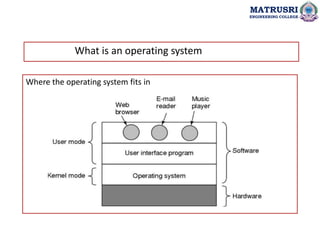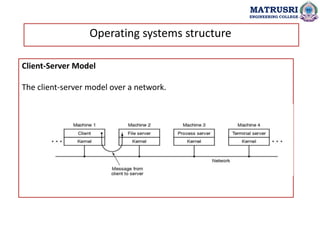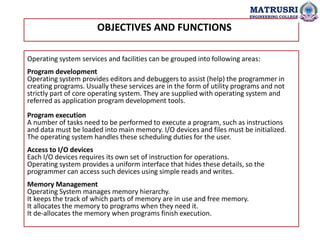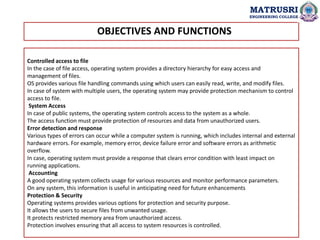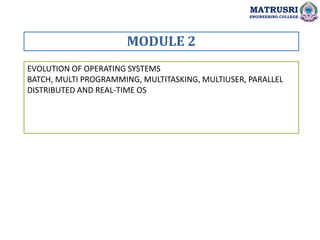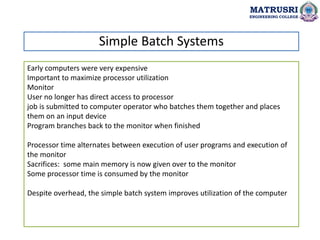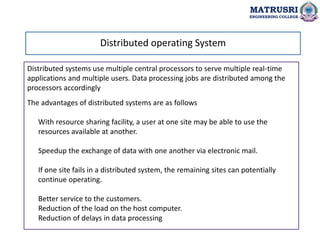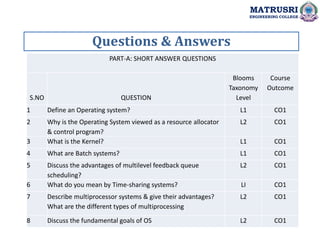Real Time Operating System ,Structures of Operating System (Monolithic, Microkernel, Layered, Exo-kernel and Hybrid kernel structures) Operating system objectives and functions, Virtual Computers Interaction of OS and Hardware architecture
- 1. MATRUSRI ENGINEERING COLLEGE DEPARTMENT OF ELECTRONICS & COMMUNICATION ENGINEERING SUBJECT NAME: REAL TIME OPERATING SYSTEMS FACULTY NAME:K VIJETHA MATRUSRI ENGINEERING COLLEGE
- 2. REAL TIME OPERATING SYSTEMS COURSE OBJECTIVES: 1.The functions performed by operating system 2.To differentiate between real time &study the scheduling algorithms 3.The concepts of process synchronization 4.The elementary concepts of Vx works 5.The fundamental concepts of UNIX operating system COURSE OUTCOMES: 1.Classify various types of kernels & operating systems 2.Analyze various scheduling algorithms related to RTOS 3.Summarize inter process communication tools 4.Understand the elementary concepts of Vx works 5.Enumerate the fundamental concepts of UNIX operating system MATRUSRI ENGINEERING COLLEGE
- 3. STRUCTURES OF OPERATING SYSTEM (MONOLITHIC, MICROKERNEL, LAYERED, EXO-KERNEL AND HYBRID KERNEL STRUCTURES), OPERATING SYSTEM OBJECTIVES AND FUNCTIONS, VIRTUAL COMPUTERS, INTERACTION OF OS AND HARDWARE ARCHITECTURE, EVOLUTION OF OPERATING SYSTEMS, BATCH, MULTI PROGRAMMING, MULTITASKING, MULTIUSER, PARALLEL, DISTRIBUTED AND REAL-TIME OS UNIT-I OUTCOMES: Classify various types of kernels & operating systems MATRUSRI ENGINEERING COLLEGE
- 4. CONTENTS: STRUCTURES OF OPERATING SYSTEM (MONOLITHIC, MICROKERNEL, LAYERED, EXO-KERNEL AND HYBRID KERNEL STRUCTURES) OPERATING SYSTEM OBJECTIVES AND FUNCTIONS, VIRTUAL COMPUTERS INTERACTION OF OS AND HARDWARE ARCHITECTURE MODULE-I MATRUSRI ENGINEERING COLLEGE
- 5. What is an operating system A modern computer consists of: • One or more processors • Main memory • Disks • Printers • Various input/output devices Managing all these components requires a layer of software – the operating system MATRUSRI ENGINEERING COLLEGE
- 6. What is an operating system Where the operating system fits in MATRUSRI ENGINEERING COLLEGE
- 7. The operating system as an extended machine Operating systems turn ugly hardware into beautiful abstractions MATRUSRI ENGINEERING COLLEGE
- 8. The operating system as a resource manager Allow multiple programs to run at the same time • Manage and protect memory, I/O devices, and other resources • Includes multiplexing (sharing) resources in two different ways: • In time • In space MATRUSRI ENGINEERING COLLEGE
- 9. Operating systems structure Monolithic systems basic structure: • A main program that invokes the requested service procedure. • A set of service procedures that carry out the system calls. • A set of utility procedures that help the service procedures A simple structuring model for a monolithic system MATRUSRI ENGINEERING COLLEGE
- 10. Operating systems structure Layered Systems Structure of the THE operating system MATRUSRI ENGINEERING COLLEGE
- 11. Operating systems structure Microkernels Structure of the MINIX 3 system MATRUSRI ENGINEERING COLLEGE
- 12. Operating systems structure Client-Server Model The client-server model over a network. MATRUSRI ENGINEERING COLLEGE
- 13. Operating systems structure Virtual Machines (1) The structure of VM/370 with CMS. MATRUSRI ENGINEERING COLLEGE
- 14. Operating systems structure Virtual Machines (2) (a) A type 1 hypervisor. (b) A type 2 hypervisor MATRUSRI ENGINEERING COLLEGE
- 15. OBJECTIVES AND FUNCTIONS Operating system services and facilities can be grouped into following areas: Program development Operating system provides editors and debuggers to assist (help) the programmer in creating programs. Usually these services are in the form of utility programs and not strictly part of core operating system. They are supplied with operating system and referred as application program development tools. Program execution A number of tasks need to be performed to execute a program, such as instructions and data must be loaded into main memory. I/O devices and files must be initialized. The operating system handles these scheduling duties for the user. Access to I/O devices Each I/O devices requires its own set of instruction for operations. Operating system provides a uniform interface that hides these details, so the programmer can access such devices using simple reads and writes. Memory Management Operating System manages memory hierarchy. It keeps the track of which parts of memory are in use and free memory. It allocates the memory to programs when they need it. It de-allocates the memory when programs finish execution. MATRUSRI ENGINEERING COLLEGE
- 16. OBJECTIVES AND FUNCTIONS Controlled access to file In the case of file access, operating system provides a directory hierarchy for easy access and management of files. OS provides various file handling commands using which users can easily read, write, and modify files. In case of system with multiple users, the operating system may provide protection mechanism to control access to file. System Access In case of public systems, the operating system controls access to the system as a whole. The access function must provide protection of resources and data from unauthorized users. Error detection and response Various types of errors can occur while a computer system is running, which includes internal and external hardware errors. For example, memory error, device failure error and software errors as arithmetic overflow. In case, operating system must provide a response that clears error condition with least impact on running applications. Accounting A good operating system collects usage for various resources and monitor performance parameters. On any system, this information is useful in anticipating need for future enhancements Protection & Security Operating systems provides various options for protection and security purpose. It allows the users to secure files from unwanted usage. It protects restricted memory area from unauthorized access. Protection involves ensuring that all access to system resources is controlled. MATRUSRI ENGINEERING COLLEGE
- 17. Computer hardware and software structure Interaction of OS & Hardware MATRUSRI ENGINEERING COLLEGE
- 18. EVOLUTION OF OPERATING SYSTEMS BATCH, MULTI PROGRAMMING, MULTITASKING, MULTIUSER, PARALLEL DISTRIBUTED AND REAL-TIME OS MODULE 2 MATRUSRI ENGINEERING COLLEGE
- 19. Stages of OS Evolution of Operating Systems MATRUSRI ENGINEERING COLLEGE
- 20. Early computers were very expensive Important to maximize processor utilization Monitor User no longer has direct access to processor job is submitted to computer operator who batches them together and places them on an input device Program branches back to the monitor when finished Processor time alternates between execution of user programs and execution of the monitor Sacrifices: some main memory is now given over to the monitor Some processor time is consumed by the monitor Despite overhead, the simple batch system improves utilization of the computer Simple Batch Systems MATRUSRI ENGINEERING COLLEGE
- 21. Multiprogramming Also known as multitasking Memory is expanded to hold three, four, or more programs and switch among all of them Multiprogramming MATRUSRI ENGINEERING COLLEGE
- 22. Can be used to handle multiple interactive jobs Processor time is shared among multiple users Multiple users simultaneously access the system through terminals, with the OS interleaving the execution of each user program in a short burst or quantum of computation BATCH MULTIPROGRAMMING VS. TIME SHARING Multi Tasking or Time-Sharing Systems MATRUSRI ENGINEERING COLLEGE
- 23. Parallel operating systems are primarily concerned with managing the resources of parallel machines. This task faces many challenges: application programmers demand all the performance possible, many hardware configurations exist and change very rapidly, yet the operating system must increasingly be compatible with the mainstream versions used in personal computers and workstations due both to user pressure and to the limited resources available for developing new versions of these system. There are several components in an operating system that can be parallelized. Most operating systems do not approach all of them and do not support parallel applications directly. Rather, parallelism is frequently exploited by some additional software layer such as a distributed file system, distributed shared memory support or libraries and services that support particular parallel programming languages while the operating system manages concurrent task execution. Parallel Processing System MATRUSRI ENGINEERING COLLEGE
- 24. Distributed systems use multiple central processors to serve multiple real-time applications and multiple users. Data processing jobs are distributed among the processors accordingly The advantages of distributed systems are as follows With resource sharing facility, a user at one site may be able to use the resources available at another. Speedup the exchange of data with one another via electronic mail. If one site fails in a distributed system, the remaining sites can potentially continue operating. Better service to the customers. Reduction of the load on the host computer. Reduction of delays in data processing Distributed operating System MATRUSRI ENGINEERING COLLEGE
- 25. A real time operating system is used, when there are rigid (strict) time requirements on the operation of a processor or the flow of data. It is often used as a control device in a dedicated application. Systems that control scientific experiments, medical imaging systems, and industrial control system are real time systems. These applications also include some home appliance system, weapon systems, and automobile engine fuel injection systems. Real time operating system has well defined, fixed time constraints. Processing must be done within defined constraints or the system will fail. Since meeting strict deadlines is crucial in real time systems, sometimes an operating is simply a library linked in with the application programs. Real Time operating System MATRUSRI ENGINEERING COLLEGE
- 26. There are two types of real time operating system Hard real system This system guarantees that critical tasks complete on time. Many of these are found in industrial process control, avionics, and military and similar application areas. This goal says that all delays in the system must be restricted. Soft real system In soft real-time system, missing an occasional deadline, while not desirable, is acceptable and does not cause any permanent damage. Digital audio or multimedia systems fall in this category. An example of real time system is ucos Real Time operating System(contd) MATRUSRI ENGINEERING COLLEGE
- 27. Questions & Answers MATRUSRI ENGINEERING COLLEGE PART-A: SHORT ANSWER QUESTIONS S.NO QUESTION Blooms Taxonomy Level Course Outcome 1 Define an Operating system? L1 CO1 2 Why is the Operating System viewed as a resource allocator & control program? L2 CO1 3 What is the Kernel? L1 CO1 4 What are Batch systems? L1 CO1 5 Discuss the advantages of multilevel feedback queue scheduling? L2 CO1 6 What do you mean by Time-sharing systems? LI CO1 7 Describe multiprocessor systems & give their advantages? What are the different types of multiprocessing L2 CO1 8 Discuss the fundamental goals of OS L2 CO1
- 28. Questions & Answers MATRUSRI ENGINEERING COLLEGE PART-B: LONG ANSWER QUESTIONS S.NO QUESTION Blooms Taxonomy Level Course Outcome 1 Explain the various types of computer systems. L2 CO1 2 Explain how protection is provided for the hardware resources by the operating system. L5 CO1 3 What are the system components of an operating system & explain them? L1 CO1 4 Explain briefly the functions of OS L2 CO1 5 Discuss about monolithic and Layered kernel structure OS L2 CO1 6 Describe in brief about interaction of operating system with the underlying hardware. L2 CO1 7 What is RTOS. Differentiate between General purpose and RTOS. L1 CO1





